Tracking moonrise times helps you plan ideal moon viewing by knowing when and where to look in the sky. Since the moon rises about 50 minutes later each day and in different positions seasonally, accurate timing guarantees you won’t miss fleeting phases like crescents. You’ll get better photographs, avoid urban obstructions, and capture clearer views when the moon is higher above atmospheric distortion. Understanding these patterns connects you to a tradition spanning thousands of years of human observation.
The Basics of Lunar Movement Patterns

While the Sun follows a relatively predictable path across our sky, the Moon dances to a more complex rhythm.
You’ll notice your lunar companion rises approximately 50 minutes later each day, a result of its eastward movement of 12-13 degrees relative to Earth.
Don’t expect consistency in moonrise times, though. The daily delay can vary from 20 to 70 minutes depending on several factors. This variation stems from the Moon’s elliptical orbital path and the tilt of its orbital plane relative to Earth.
The Moon’s rising position also shifts seasonally, moving between east-northeast and east-southeast throughout the year.
Understanding Moon Phase Visibility Windows
To maximize your moon-viewing experience, you’ll need to understand how long each lunar phase remains visible, which varies from the brief appearance of a crescent to the all-night presence of a full moon.
You can predict when the moon will rise by adding roughly 50 minutes to yesterday’s moonrise time or by consulting astronomical apps and websites that calculate precise timings based on your location.
These visibility windows shift throughout the month, with full moons offering the longest viewing opportunities from sunset to sunrise, while waning phases become increasingly visible in pre-dawn hours.
Visibility Window Duration
Understanding when the Moon will be visible in your night sky depends largely on its current phase. A full moon offers the longest visibility window, remaining viewable throughout the entire night, while a new moon is practically invisible.
The waning gibbous phase provides excellent viewing opportunities from late night until early morning—perfect for early risers seeking pre-dawn lunar observations.
- Each night, moonrise occurs about 50 minutes later than the previous day, shifting your ideal viewing window.
- Full moons rise at sunset and set at sunrise, maximizing your viewing opportunity.
- Waxing phases are best viewed in evening hours, while waning phases favor morning observers.
- The Moon’s height in the sky affects visibility quality—higher positions typically offer clearer views.
Tracking these visibility windows helps you plan your lunar photography or observation sessions with precision.
Moonrise Prediction Methods
Predicting when the Moon will rise requires more than casual observation, especially if you want to enhance your viewing opportunities. By understanding the lunar cycle’s 29.5-day pattern, you’ll gain insight into moonrise timing, which delays roughly 50 minutes each day due to the Moon’s eastward movement.
| Phase | Moonrise Time | Best Visibility |
|---|---|---|
| New | Sunrise | Poor (not visible) |
| Waxing Crescent | Morning to Afternoon | Evening after sunset |
| First Quarter | Noon | Evening until midnight |
| Waxing Gibbous | Afternoon | Evening to early morning |
| Full | Sunset | All night |
Track both moonrise and moonset times to plan your observation sessions effectively. The waning gibbous phase offers excellent late-night to early-morning visibility windows. By anticipating these patterns, you’ll position yourself for prime viewing conditions when atmospheric clarity is highest.
Planning Night Photography Around Moonrise
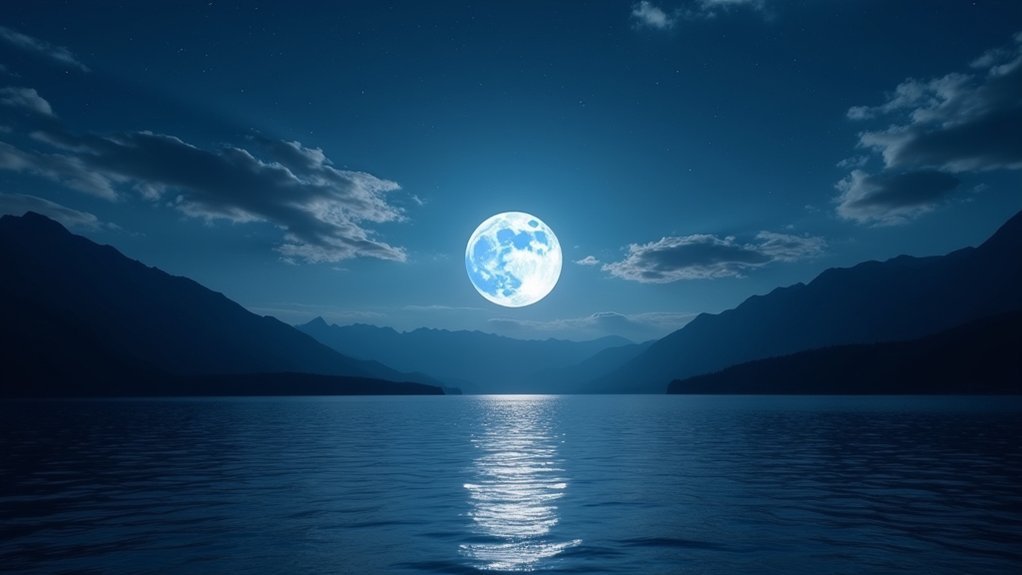
When the moon ascends above the horizon, it presents photographers with a fleeting window of golden opportunity.
You’ll need to account for the moon’s daily 50-minute delay in rising times to capture its ideal position in your night sky compositions. Track moonrise using lunar calendars or specialized apps to plan your photography sessions around favorable lighting conditions, especially for dramatic events like supermoons.
- Position yourself to incorporate foreground elements while the moon hovers low on the horizon
- Monitor atmospheric clarity to anticipate the moon’s color and visibility
- Schedule sessions 10-15 minutes before calculated moonrise to set up equipment
- Note the moon phase to determine brightness and exposure settings
Remember that weather conditions can dramatically affect your shoot, so always check forecasts alongside your moonrise schedule.
Geographic Factors Affecting Viewing Times
Your latitude directly impacts when you’ll see the moon rise and set, with northern and southern hemispheres experiencing particularly different viewing times throughout the year.
Local terrain features like mountains or urban skylines can delay your actual moonrise viewing by blocking the moon until it climbs higher above your horizon.
You’ll need to account for these geographic variables when planning observation sessions, especially if you’re in areas with significant elevation changes or distinctive landscape features.
Latitude’s Viewing Impact
Geographic location plays an essential role in how you’ll experience moonrise and moonset events. Your latitude greatly determines the Moon’s angle as it rises and sets, directly affecting its visibility and time above the horizon.
At higher latitudes, you’ll notice more dramatic seasonal variations in moonrise times and potentially longer viewing opportunities during summer months.
- Northern observers experience extended twilight periods, sometimes keeping the Moon visible longer.
- Polar regions can enjoy continuous Moon visibility for days during certain seasons.
- The Moon’s path varies more dramatically with seasons at higher latitudes.
- Your specific geographic location determines whether moonrise occurs during day or night.
Understanding how your latitude impacts lunar visibility helps you plan ideal viewing times and anticipate how the Moon will appear from your location throughout the year.
Terrain and Horizon Effects
Beyond latitude’s general influence, the specific terrain surrounding your observation point greatly shapes your moonrise viewing experience.
If you’re in mountainous areas, you’ll notice delayed moonrise times as elevated landscapes obstruct your line of sight to the horizon. Conversely, coastal locations offer earlier visibility with their unimpeded views.
Urban environments present unique challenges, with buildings frequently blocking the horizon and delaying when you’ll first glimpse the rising moon.
Your local terrain doesn’t just affect timing—it also impacts visibility quality. Atmospheric conditions play a vital role too; haze, pollution, and high humidity can greatly diminish the clarity of moonrise observations even when timing is perfect.
For ideal viewing, seek locations with clear sightlines to the eastern horizon and minimal atmospheric interference, allowing you to fully appreciate the moon’s appearance.
Seasonal Variations in Moonrise Positions
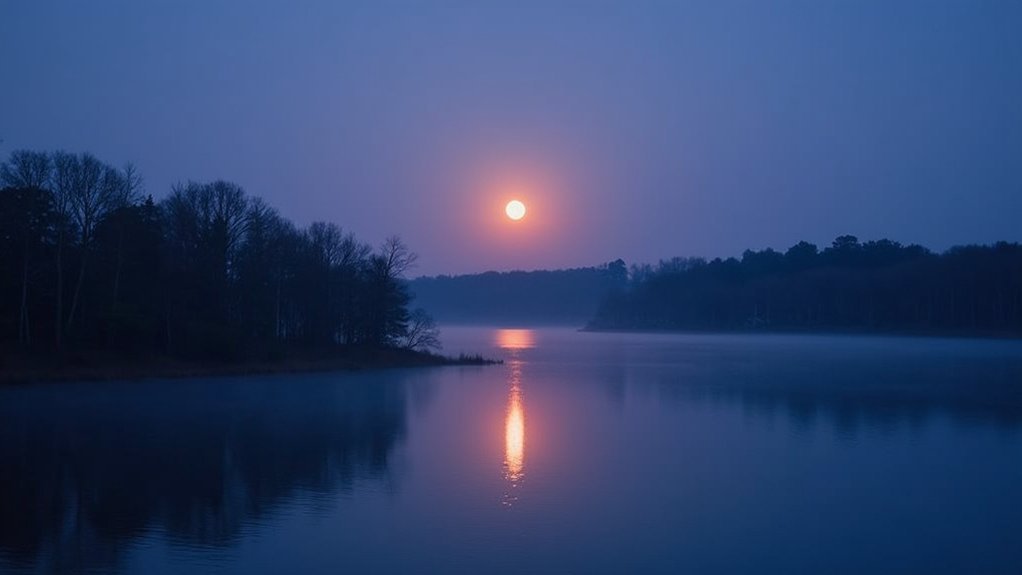
While tracking the Moon’s position remains consistent throughout the year, its rising location on the horizon shifts dramatically with the seasons.
The Moon’s behavior follows predictable patterns, yet its rising point wanders significantly as Earth dances through its seasonal waltz.
You’ll notice the Moon rises from the east-northeast during summer months, creating higher arcs across the night sky. In winter, it emerges from the east-southeast, resulting in lower trajectories.
These seasonal variations in moonrise positions occur due to Earth’s axial tilt, following an 18.6-year cycle that affects your lunar observations.
Understanding these horizon positions helps you:
- Plan photography sessions to capture the Moon at its most dramatic angles
- Anticipate visibility based on seasonal moonrise locations
- Adjust viewing times as the Moon shifts between northern and southern rising points
- Schedule long-term observations accounting for the multi-year cycle in lunar positioning
Optimal Viewing Times for Different Moon Phases
To maximize your lunar observations, you’ll need to match your viewing schedule with the moon’s distinct phases.
For best viewing of a full moon, head outside around sunset when it rises and remains visible all night until dawn—this offers the brightest lunar visibility.
If you’re tracking a waning gibbous moon, plan your observation from midnight until early morning hours when it dominates the sky.
For the last quarter phase, midnight is your starting point, as this is when moonrise occurs, making the next few hours ideal for viewing.
Remember that the moon rises approximately 50 minutes later each night, requiring you to adjust your schedule accordingly.
The new moon presents a special challenge, as its position between Earth and Sun renders it practically invisible.
Using Mobile Apps to Track Lunar Appearances
Modern smartphone technology has transformed how we monitor the night sky, particularly when tracking the moon’s movements.
Mobile apps provide precise moonrise times based on your exact location, ensuring you’ll never miss important lunar events. These apps use real-time data and sophisticated algorithms to predict moon phases and visibility conditions.
- Get personalized notifications for supermoons, eclipses, and other special lunar events
- Utilize augmented reality features to visualize the moon’s path across your local sky
- Access detailed information about moon phases, brightness, and atmospheric conditions
- Compare multiple viewing locations to find ideal spots for lunar photography
The Connection Between Tides and Moon Position
Although often taken for granted, the rhythmic ebb and flow of Earth’s oceans directly results from the Moon’s gravitational influence. As the Moon rises and sets, tidal patterns follow its journey across the sky, creating predictable cycles you can track.
| Moon’s Position | Tidal Effect |
|---|---|
| Rising/Setting | Changing tide direction |
| Full/New Moon | Higher spring tides |
| Perigee | Remarkably higher tides |
| Apogee | Slightly lower tides |
The lunar orbit creates approximately two high and two low tides every 24 hours. By understanding this relationship, you’ll know when to expect extreme tides during full moons or when the Moon is closest to Earth. Tracking Moon rises alongside tide tables allows you to plan beach activities, fishing expeditions, or coastal photography with greater precision.
Calibrating Observation Equipment for Moonrise
To prepare your observation gear for moonrise, you’ll need to optimize your lens aperture based on the moon’s 50-minute-later daily appearance and its 12-13 degree eastward movement.
Calibrate your exposure settings by consulting lunar calendars that provide precise rising times, adjusting for the atmospheric conditions that affect visibility and color.
Align your mount tracking system to compensate for the moon’s changing nightly position, ensuring your equipment maintains focus as the lunar body emerges into view.
Lens Aperture Optimization
When tracking the elusive moment of moonrise, proper calibration of your lens aperture becomes essential for capturing the moon’s details as it emerges from the horizon.
Your aperture choice directly affects visibility during the low-light conditions typical of moonrise, with settings between f/8 and f/11 offering an excellent balance between depth of field and sharpness.
You’ll need to adjust your aperture based on atmospheric conditions and the moon’s phase. A full moon requires a smaller aperture to prevent overexposure, while crescent phases need larger apertures to capture sufficient detail.
- Consider the moon’s position relative to the horizon when selecting aperture
- Use larger apertures during initial moonrise for better light gathering
- Adjust settings as the moon rises and atmospheric interference decreases
- Monitor how different phases affect ideal aperture requirements
Exposure Settings Calibration
Proper exposure settings become critical for capturing the moon’s delicate features, especially since its position shifts approximately 50 minutes later each day.
When calibrating your equipment for moonrise, adjust your exposure settings based on the moon’s current phase—waning gibbous phases require different settings than new or full moons.
Consider the lunar cycle’s 29.5-day rhythm when planning your observations, as this knowledge helps you anticipate ideal viewing conditions.
The moon’s yellowish appearance near the horizon results from atmospheric scattering, requiring you to modify your settings to capture true colors.
Don’t forget that the moon’s angular speed varies throughout its elliptical orbit, affecting precise moonrise timing.
Mount Tracking Alignment
Achieving precise mount tracking alignment serves as the foundation for successful lunar observation and photography.
When you properly calibrate your equipment to account for the Moon’s daily rise time shift of approximately 50 minutes, you’ll capture clearer, more detailed images.
Aligning your tracking mount with the celestial equator enables smoother movement as you follow the Moon’s eastward trajectory of 12-13 degrees each day.
- Align your mount to compensate for the Moon’s rise time delays for consistent tracking accuracy
- Position your equipment parallel to the celestial equator for ideal movement paths
- Make regular adjustments based on the Moon’s changing position to maintain focus
- Use the Moon’s orbital characteristics to predict and prepare for tracking adjustments
Proper alignment guarantees your equipment smoothly follows lunar movements, transforming casual viewing into exceptional lunar observations.
Cultural and Historical Significance of Tracking Moonrise
Throughout human civilization, the tracking of moonrise times has shaped countless cultural practices and historical developments. When you study ancient Babylonian and Mayan societies, you’ll discover they meticulously recorded moonrise times to establish lunar calendars that governed agricultural cycles and religious festivals.
The moon’s predictable journey across our skies has guided humanity’s greatest civilizations from their earliest days.
The moon’s phases weren’t just beautiful celestial events—they served practical purposes for navigation. Sailors relied on predictable moonrise patterns to guide their journeys across vast oceans.
In Asia, the precise timing of moonrise remains central to celebrations like the Mid-Autumn Festival, where families gather under the full moon to celebrate harvest.
Indigenous peoples, from North American tribes to Arctic Inuit communities, integrated moonrise timing into their hunting practices and seasonal rituals. Their cultural traditions demonstrate how lunar calendars have been essential tools for human survival and spiritual connection.
Predicting Moonrise Against Notable Landmarks
When you want to capture the perfect shot of the moon rising behind a famous landmark, predicting moonrise timing becomes both an art and a science. By tracking the moon’s position and understanding its 50-minute daily delay pattern, you’ll create striking compositions that blend celestial events with earthbound structures.
Seasonal variations affect moonrise directions, allowing you to plan landmark photography throughout the year. Understanding these cycles helps you align your viewing experience with specific landmarks for maximum visual impact.
- Use lunar calendars to coincide moonrise with significant phases like full moons
- Calculate the 50-minute daily delay to position yourself at the perfect time
- Research seasonal moonrise directions to anticipate alignments with landmarks
- Plan photography sessions when the moon serves as a dramatic backdrop to notable structures
Atmospheric Conditions and Their Impact on Visibility
While planning your landmark moonrise photography requires precise timing, the atmosphere itself plays a major role in what you’ll actually see. Humidity, air pollution, and weather conditions directly impact the Moon’s clarity and brightness during moonrise.
The atmosphere is your co-creator in moonrise photography, affecting every aspect from visibility to color and mood.
You’ll notice the Moon often appears yellowish or reddish near the horizon due to light scattering through a thicker layer of atmosphere.
Tracking moonrise times becomes especially important when atmospheric conditions are variable. Clouds and fog can completely obscure your view, while different atmospheric layers might create interesting optical phenomena like halos.
For the best visibility, moonrise and moonset typically offer enhanced viewing experiences with reduced glare compared to when the Moon is higher in the sky. Understanding these atmospheric influences helps you anticipate and adapt to changing visibility conditions.
Recording and Documenting Your Lunar Observations
Accurate record-keeping forms the backbone of meaningful lunar observation. By maintaining a journal of moonrise and moonset times, you’ll notice the approximately 50-minute daily shift in timing, enhancing your prediction abilities.
Track the Moon’s position against background stars to understand its eastward movement throughout the lunar cycle.
- Use trusted lunar calendars from NASA or the Old Farmers Almanac to plan ideal viewing sessions
- Document atmospheric conditions like humidity and clarity to explain visibility variations
- Note the Moon’s changing position relative to constellations for a deeper understanding of lunar motion
- Record observation dates and times precisely to establish patterns over the lunar month
Analyzing your lunar observations over time reveals predictable patterns that’ll transform your casual moongazing into a more rewarding astronomical experience.
Frequently Asked Questions
What Is the Best Way to View the Moon?
View the Moon during waxing/waning phases when it’s near the horizon after moonrise or before moonset. You’ll see more detail and experience the Moon illusion, making it appear larger and more colorful.
Why Does the Moon Rise and Set at Different Times as It Passes Through Its Various Phases?
The moon rises ~50 minutes later each day because it orbits Earth eastward at 12-13 degrees daily. As it moves through phases, you’ll notice its position relative to the Sun changes, affecting its rise/set times.
How Does the Moon Affect Star Visibility?
When the Moon’s bright, you’ll see fewer stars—especially during a full Moon. As it wanes, you’ll notice more stars appearing. During crescent phases, you’ll enjoy darker skies perfect for spotting fainter celestial objects.
What Does Moon Rise Time Mean?
Moonrise time marks when you’ll first see the moon appear above your horizon. It changes daily, occurring about 50 minutes later each day as the moon completes its orbit around Earth.
In Summary
Tracking moonrise times isn’t just about convenience—it’s your gateway to experiencing lunar magic at its finest. You’ll capture better photographs, witness spectacular alignments, and develop a deeper connection to astronomical rhythms that humans have followed for millennia. Whether you’re a casual observer or dedicated enthusiast, understanding when and where the moon will appear transforms your viewing from random chance to purposeful adventure.


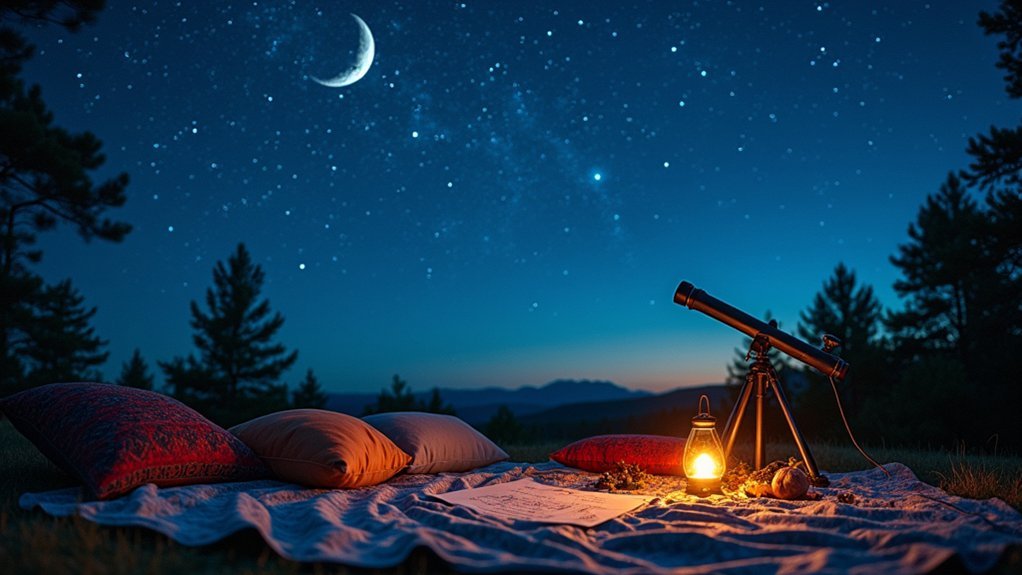
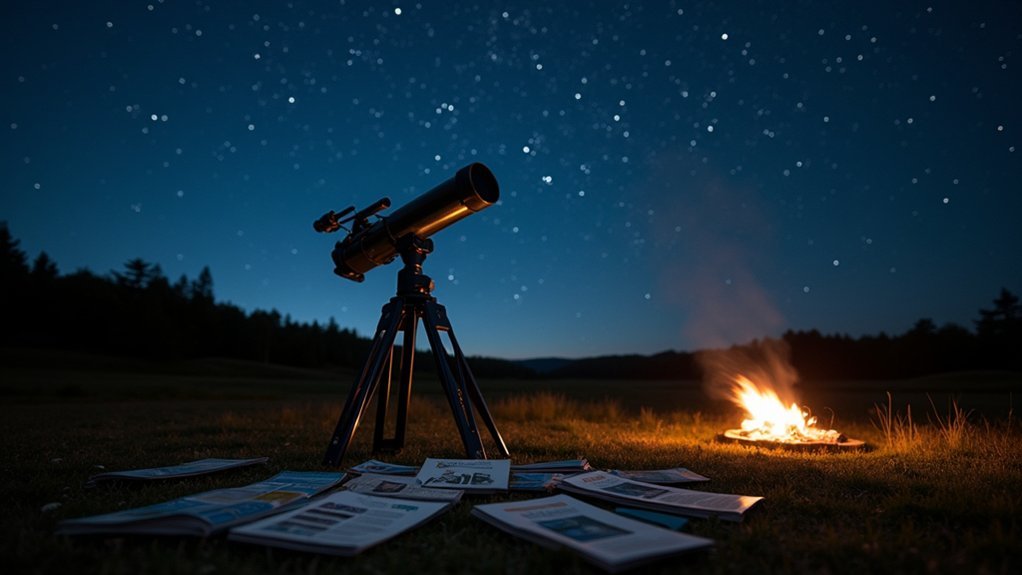
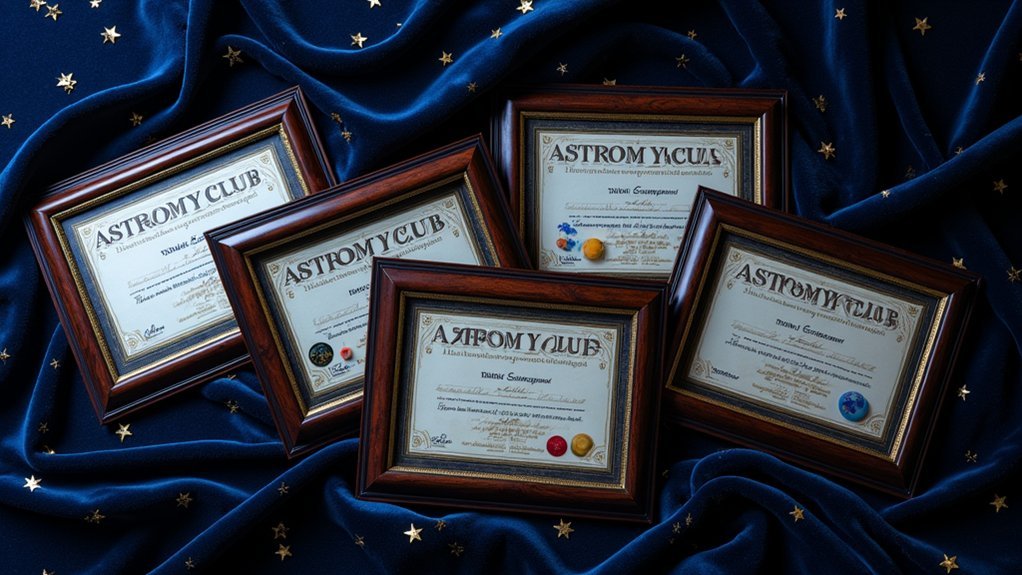
Leave a Reply